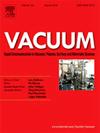HfO2/DZ125 复合材料中 HfC/HfO2 的界面结合和异质成核机制:第一原理计算和实验的启示
IF 3.8
2区 材料科学
Q2 MATERIALS SCIENCE, MULTIDISCIPLINARY
引用次数: 0
摘要
本文通过第一性原理计算了DZ125镍基超级合金中析出相(碳化物)和添加相(HfO2)的界面结合强度,以及以HfO2为异质基底的碳化物成核势。结果表明,HfC(011)/HfO2(011)和 HfC(111)/HfO2(011) 的错配满足半相干关系。计算了六种具有不同端点和堆积序列的界面结构的粘附功(Wad)和界面能。HfC(111)/HfO2(011)中的模型 3 显示出最高的 Wad (6.67 J/m2),界面间距为 0.95 Å,界面能范围为 -3.2-1.81 J/m2,表明界面结合强度最强。电子结构分析证实,模型 3 中的强键合是由于在界面上形成了牢固的 Hf-C 共价键。单轴拉伸试验表明,模型 3 具有较宽的应变范围和较高的拉伸强度,Hf-C 键能保持其完整性而不会断裂。模型 3 是最稳定的结构,支持 HfC 在 HfO2 上的粘附和生长。实验证实,HfO2 可作为 HfC 的异质成核场所,有助于 HfC 晶粒的细化。本文章由计算机程序翻译,如有差异,请以英文原文为准。
Interfacial binding and heterogeneous nucleation mechanisms of HfC/HfO2 in HfO2/DZ125 composites: Insights from first-principles calculations and experiments
In this paper, the interfacial bonding strengths of the precipitated phase (carbides) and addition phase (HfO2) in the DZ125 nickel-based superalloy, as well as the nucleation potential of carbides with HfO2 as a heterogeneous substrate, were calculated by first-principles calculations. Results show that the mismatches of HfC(011)/HfO2(011) and HfC(111)/HfO2(011) satisfy the semi-coherent relationship.
Adhesion work (Wad) and interfacial energy were computed for six interfacial structures with varying terminations and stacking sequences. Model 3 in HfC(111)/HfO2(011) exhibited the highest Wad (6.67 J/m2), with an interfacial spacing of 0.95 Å and interfacial energy ranging from −3.2–1.81 J/m2, indicating the strongest interfacial bonding strength. Electronic structure analysis confirmed that the strong bonding in Model 3 is due to the formation of a robust Hf-C covalent bond at the interface. Uniaxial tensile tests revealed that Model 3 has a broad strain range and high tensile strength, with the Hf-C bond maintaining its integrity without fracture. Model 3, the most stable structure, supports the adhesion and growth of HfC on HfO2. The experiment confirms that HfO2 can serve as a heterogeneous nucleation site for HfC and contribute to the refinement of HfC grains.
求助全文
通过发布文献求助,成功后即可免费获取论文全文。
去求助
来源期刊

Vacuum
工程技术-材料科学:综合
CiteScore
6.80
自引率
17.50%
发文量
0
审稿时长
34 days
期刊介绍:
Vacuum is an international rapid publications journal with a focus on short communication. All papers are peer-reviewed, with the review process for short communication geared towards very fast turnaround times. The journal also published full research papers, thematic issues and selected papers from leading conferences.
A report in Vacuum should represent a major advance in an area that involves a controlled environment at pressures of one atmosphere or below.
The scope of the journal includes:
1. Vacuum; original developments in vacuum pumping and instrumentation, vacuum measurement, vacuum gas dynamics, gas-surface interactions, surface treatment for UHV applications and low outgassing, vacuum melting, sintering, and vacuum metrology. Technology and solutions for large-scale facilities (e.g., particle accelerators and fusion devices). New instrumentation ( e.g., detectors and electron microscopes).
2. Plasma science; advances in PVD, CVD, plasma-assisted CVD, ion sources, deposition processes and analysis.
3. Surface science; surface engineering, surface chemistry, surface analysis, crystal growth, ion-surface interactions and etching, nanometer-scale processing, surface modification.
4. Materials science; novel functional or structural materials. Metals, ceramics, and polymers. Experiments, simulations, and modelling for understanding structure-property relationships. Thin films and coatings. Nanostructures and ion implantation.
 求助内容:
求助内容: 应助结果提醒方式:
应助结果提醒方式:


